The Fender and Squier Jaguar electric guitar models are very versatile due to their controls, however they can be a bit confusing if its the first time you’ve ever picked one up. In this article, I’ll go through each Jaguar model and what all the controls do.
The Quick Answer
The original Jaguar electric guitar has a lead/ rhythm switch which activates different circuits. The lead circuit has a bridge pickup switch, neck pickup switch, tone cut switch and master volume and tone controls. The rhythm circuit uses the neck pickup only and uses separate volume and tone controls.
However, there are several main models of Jaguar which all have different pickup configurations and controls:
- Classic Jaguar (two single coils) e.g. Squier Classic Vibe, Fender Vintera ’60s and Fender American Original ’60s.
- Fender Player Jaguar (humbucker and single coil)
- Fender Kurt Cobain Jaguar (two humbuckers)
- Squier Contemporary Jaguar (two humbuckers)
- Modified Fender Vintera Jaguar (two humbuckers)
Whilst this article might seem a bit overwhelming at first glance, it’s very straightforward once you know which model your Jaguar is.
I’ve split this article into sections to address each guitar type above so you can easily figure out what your guitar’s controls do. Remember, if you’re unsure, you can check the headstock, or look at the pickup configuration.
Classic Jaguar (Two Single Coils)
The classic Jaguar design has two single coil pickups. Models that feature these controls include the Squier Classic Vibe, Fender Vintera ’60s and Fender American Original ’60s.
There are 3 main areas of controls on this guitar to consider:
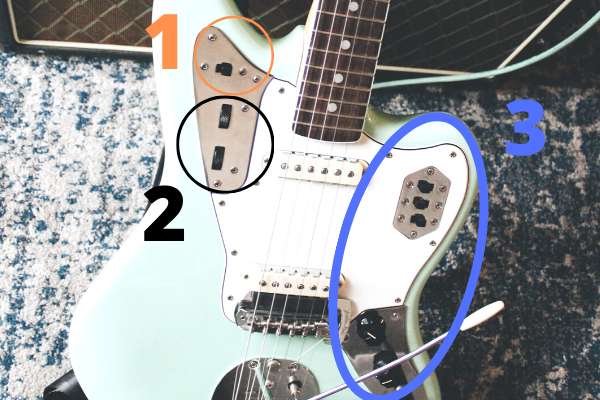
- Lead/Rhythm Switch: this allows you to activate either section 2 or 3. The rhythm position (upwards, or left on the photo) activates section 2, and the lead position (downwards, or right on the photo) activates section 3.
- Rhythm controls: these are activated when the lead/rhythm switch is in the upwards position.
- Lead controls: these are activated when the lead/ rhythm switch is in the downward position.
Lead and Rhythm Switch
- This activates either the rhythm or lead circuit, which produces a different sound and activates different controls.
- The up position activates the rhythm circuit. This sounds darker and deeper, as it only activates the neck pickup. It also gives you access to the rhythm tone and volume control, and bypasses the controls on the lower half of the guitar.
- The downward position activates the lead circuit. This sound brighter and gives you access to both pickups. It also activates the rest of the controls on the lower half of the guitar, and bypasses the rhythm tone and volume.
The idea of the rhythm and lead switch is to allow you to quickly change to very different tones and volumes during a song without using pedals or adjusting an amplifier.
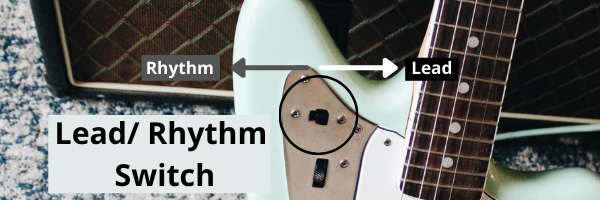
Now let’s take a look at what happens when you use this switch to activate either the rhythm or lead circuits.
Lead Circuit
In the lead circuit, the tone sounds brighter and you can use both pickups. This gives you access to the lead circuit controls: the master tone, master volume, pickup selector and tone cut switch.
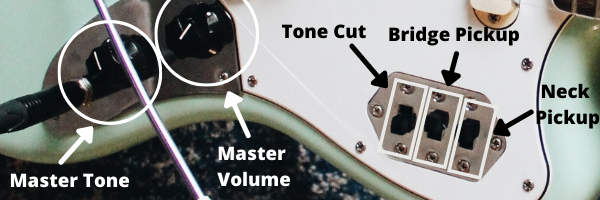
- Neck pickup switch allows you to activate this pickup which sounds mellow and dark. The up position means the pickup is activated.
- Bridge pickup switch allows you to activate this pickup which sounds bright and crisp. The up position means the pickup is activated.
- Tone Cut: this is also known as the “strangle” switch. It adds a capacitor into the signal which cuts low-end (bass) frequencies, giving the tone a brighter quality.
- Master tone: this adjusts the brightness of each pickup. Decreasing the master tone reduces the treble frequencies, causing the tone to sound more mellow.
Check out my article on bridge vs neck pickups to learn more about the tonal differences.
Rhythm Circuit
When the rhythm circuit is activated, only the neck pickup will be activate, and the bridge pickup and lead controls (pickup selector and tone cut) will all be bypassed. The rhythm circuit sounds darker and more mellow than the lead circuit, even if you have the neck pickup activated on it’s own in the lead circuit, as it adds a capacitor to create this tonal change.
The rhythm circuit gives you access to two controls on the upper half of the guitar: rhythm tone and rhythm volume.
- Rhythm volume: you can turn this up by rolling it towards the headstock.
- Rhythm tone: you can turn this up by rolling it towards the headstock. Decreasing the tone control will reduce the treble frequencies and make the guitar sound more mellow.
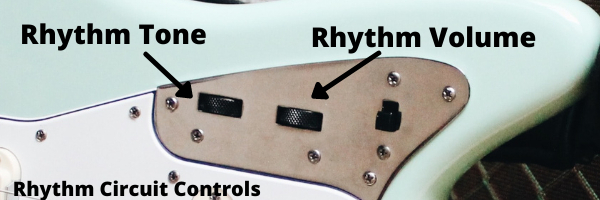
Fender Player Jaguar (Humbucker and Single Coil)
The Fender Player Jaguar has a humbucker pickup in the bridge position and a single coil pickup in the neck position. It has 4 controls:
- Coil split: this is located at the top of the guitar and is a slide switch which can be rolled backwards (towards the bridge) to coil split the humbucker to make it sound more like a single coil pickup. This causes the tone to be brighter and sharper, but a bit thinner in the coil split position.
- Three way pickup selector: in the first position (closest to the neck) the neck pickup be activated, in the middle position the neck and bridge pickup will be activated, and in the third position (closest to the bridge) the bridge pickup will be activated. The bridge pickup sounds bright whilst the neck pickup sound warm and mellow. Check out my article on bridge vs neck pickups to learn more about the tonal differences.
- Master tone: this adjusts the brightness of each pickup. Decreasing the master tone reduces the treble frequencies, causing the tone to sound more mellow.
- Master volume: adjusts the volume of both pickups.
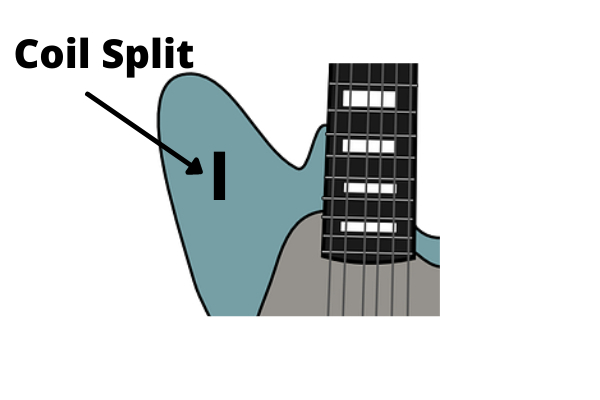
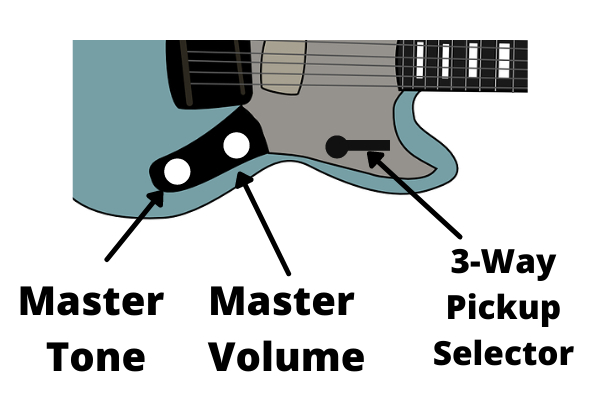
Fender Kurt Cobain Jaguar (Two Humbuckers)
The Fender Kurt Cobain Jaguar has two humbucker pickups and the controls function slightly differently compared to the classic Jaguar with two single coils. Here are the main controls and their functions:
- Lead/ Rhythm Switch: this activates two different circuits. The “up” position activates the rhythm circuit and the “down” position activates the lead circuit.
- Lead Circuit Controls: the lead circuit allows you to activate the bridge pickup, neck pickup or both together using the 3-way pickup selector. Each pickup also has a volume control and there is a single master tone control to adjust the brightness of both pickups.
- Rhythm Circuit Controls: the rhythm circuit bypasses the lead circuit controls entirely, and activates only the neck pickup. It has individual rhythm volume and rhythm tone controls.
The idea of the two circuits is to allow you to quickly and easily change the tone and volume of the guitar and essentially set it up with two tones, using the rhythm/ lead switch to flick between them.
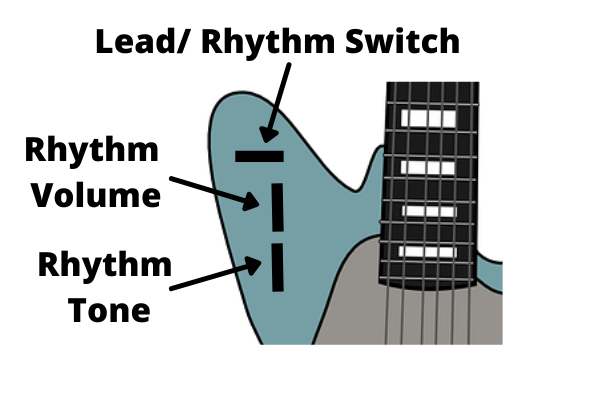
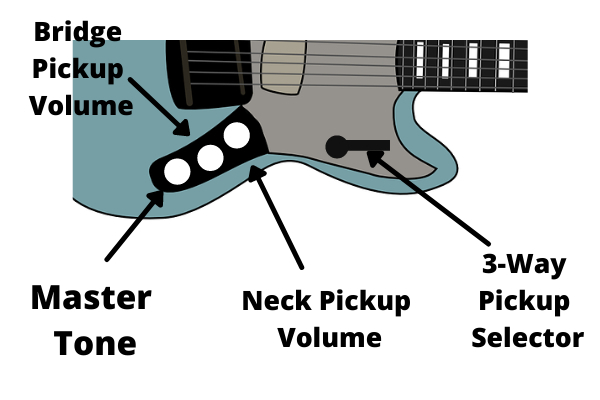
Want to be better guitar player faster? Check out this 14 day free-trial for Guitar Tricks to access over 11,000 lessons and 1000 songs to become a better player today.
Squier Contemporary Jaguar (Two Humbuckers)
The Squier Contemporary Jaguar has two humbucker pickups and features pretty different controls to the classic single coil Jaguar. Here are the controls and their functions:
- 3-way pickup selector: this allows you to activate the bridge pickup only, neck pickup only, or both pickups together.
- Master volume: adjusts the loudness of both pickups.
- Master tone: adjusts the brightness of both pickups. Rolling this back (downwards) will cut the treble frequencies to make the tone more mellow.
- Coil tap: this can be used to make the humbucker pickups sound more like single coil pickups. It produces a crisper and brighter tone but sounds thinner. Pushing it down causes it to enter the coil split position.
- Series/ Paralell Switch: pushing this switch towards the bridge activates the series switch which is louder and boosts the mid-range. Pushing the switch towards the neck causes the mids to become “scooped” by cutting them.
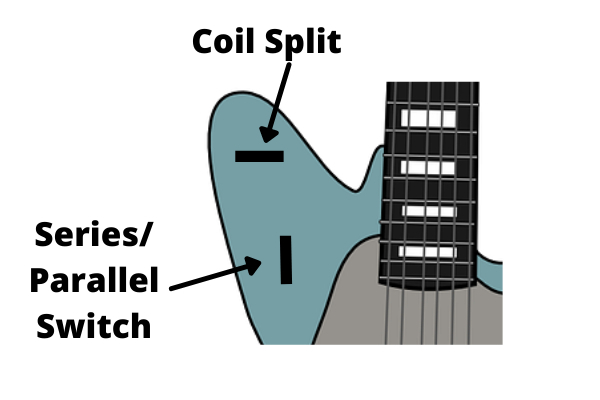
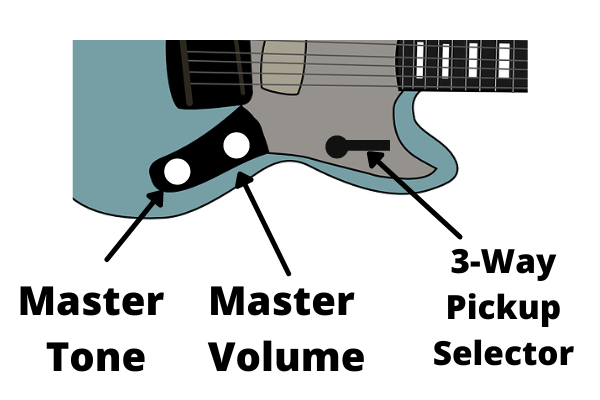
Modified Vintera (Two Humbuckers)
The Fender Vintera Modified Jaguar has two humbucker pickups and controls which function slightly differently to the standard Vintera Jaguar.
- Kill Switch: this can be pushed downwards to make it sound like the guitar is turned off but without any buzzing. The technique of turning the kill switch on and off rapidly is commonly used by Tom Morello for example in “Know Your Enemy”.
- Coil split: this is located at the top of the guitar and is a slide switch which can be rolled backwards (towards the bridge) to coil split the humbucker to make it sound more like a single coil pickup. This causes the tone to be brighter and sharper, but a bit thinner in the coil split position. There is a coil split for each humbucker.
- Neck Pickup Switch: allows you to activate this pickup which sounds mellow and dark. The up position means the pickup is activated.
- Bridge Pickup Switch: allows you to activate this pickup which sounds bright and crisp. The up position means the pickup is activated.
- Tone Cut: this is also known as the “strangle” switch. It adds a capacitor into the signal which cuts low-end (bass) frequencies, giving the tone a brighter quality.
- Master Tone: this adjusts the brightness of each pickup. Decreasing the master tone reduces the treble frequencies, causing the tone to sound more mellow.
- Master Volume: adjusts the volume of both pickups.
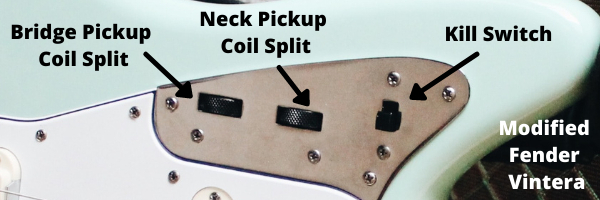
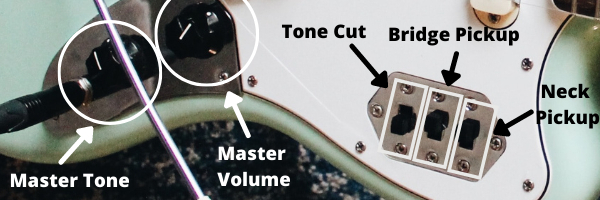
Here are some more articles you might find useful:
